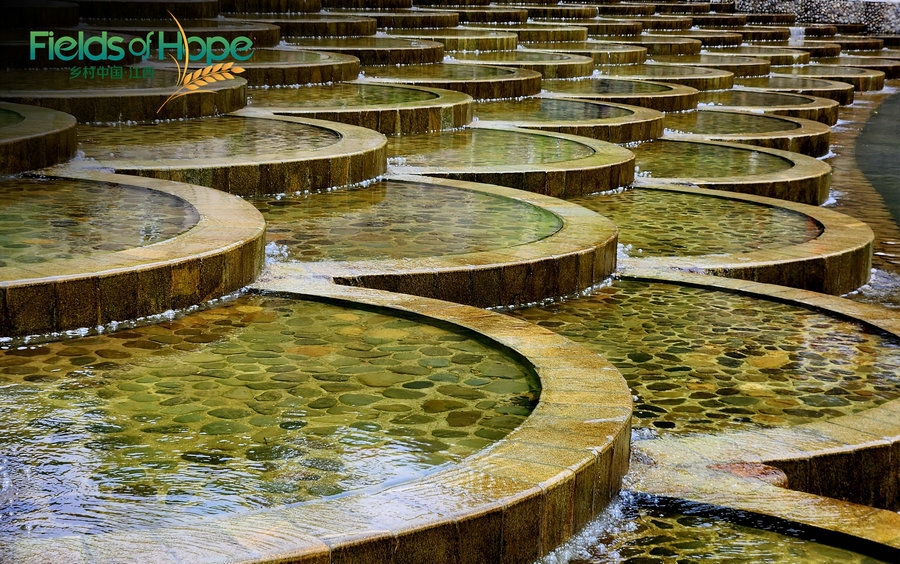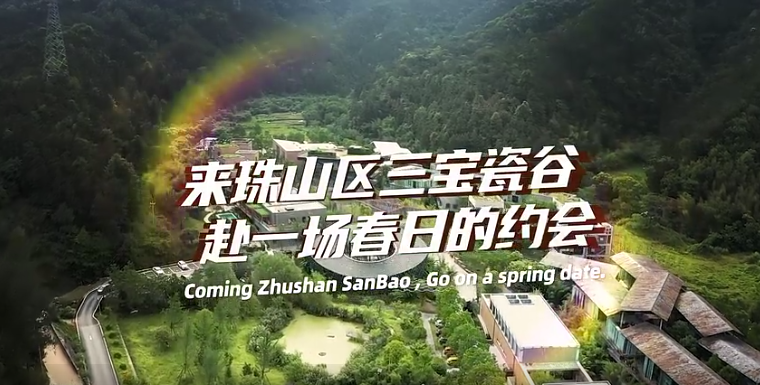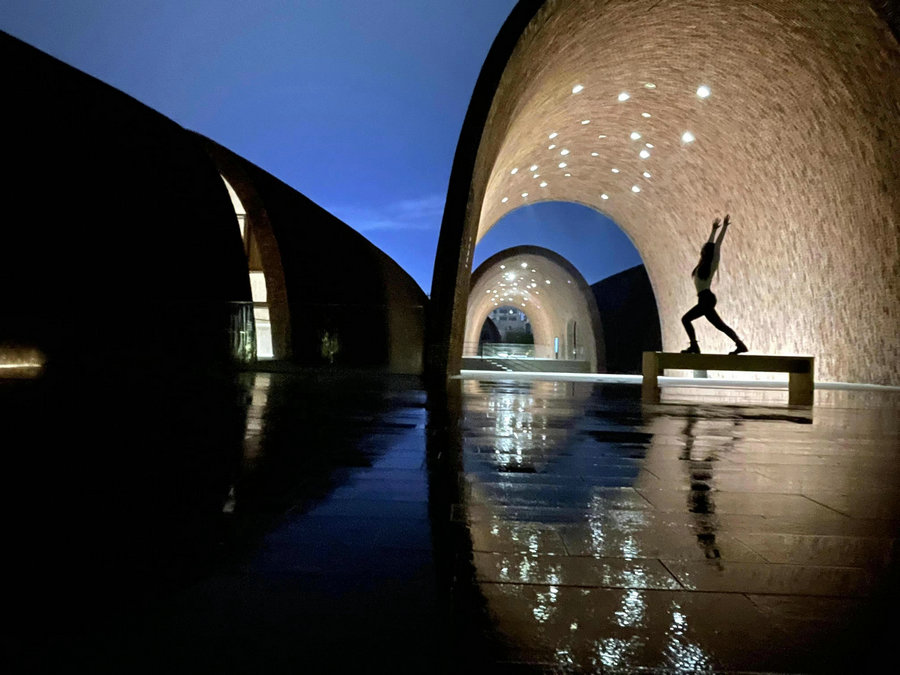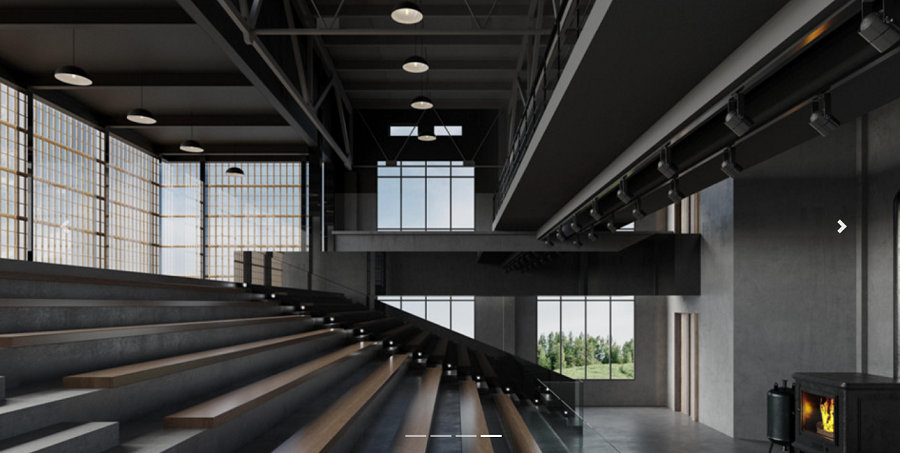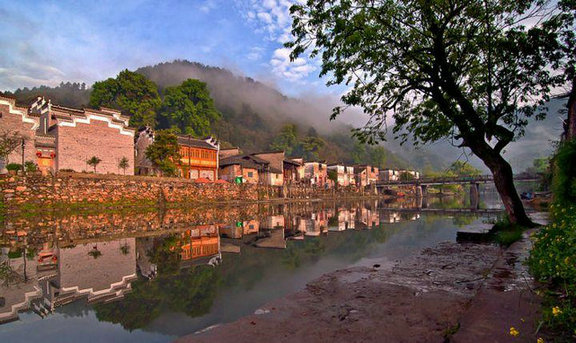

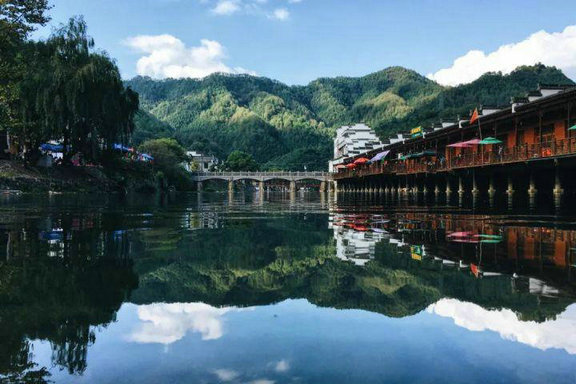
I.Overview
Ace of Jingdezhen porcelain. “Yao” is the Chinese pronunciation of “kiln”. As early as the Mid-Tang Dynasty, there were workshops here making porcelain. Located in northeastern Jingdezhen, Yaoli is also the conjoining place of the three surrounding World Cultural Heritages (Mount Huang, Lushan Mountain, and Xidi and Hong Village). Known as the origin of porcelain-making, the hometown of tea and the sea of dense forest, Yaoli boasts many awards, such as the national key scenic spot, national historical and cultural town, national 4A-level tourist attraction, national mine park, national forest park, a national key cultural relic protection site, national cultural and natural heritage. With a total planned area of 195 square kilometers, Yaoli has 94% forest coverage and is a popular destination where tourists can find 180 kinds of rare species like Chinese yews, ginkgoes, Chinese torreyas, leopards, and Andrias davidianus. Wuhua Mountain, as the highest peak of mountains here, is as high as 1618.4 meters and is also the east headwater of the Changjiang River of Jingdezhen.
Yaoli is a god-blessed land rich in culture and nurturing of talented people. It’s the hometown of Wu Rui, a lord of Changsha in the Western Han Dynasty, Li Chunnian, founding marquis of the Southern Song Dynasty, Wu Congzhi, a deputy minister in the Qing Dynasty. Chen Yi, one of the founding marshals of the People’s Republic of China, lead the reorganization of the New Fourth Army during his work and stay here in Yaoli. Visiting this town, you can enjoy both the cultural heritage and the natural beauty. As a famous tourist attraction, Yaoli combines mountains, woodland, waterfalls, valley and other natural scenery with ancient town, ancient kiln sites and other cultural landscape as a whole.
II. The Long Standing Porcelain Culture
The main material of porcelain making-kaolin clay, named after Kaolin Village here in Yaoli, is still abundant in resource in the densely forested mountains, even after the excavation of it for a thousand years. Entering into the 18th century, kaolin, as the material excavated from here for the manufacture of porcelain, became known to other countries and was accepted as a technical term in international clay mineralogy. Between the Song and Yuan Dynasties, the value of kaolin was so highly recognized that it was used extensively in ceramic industry, bringing forth the formula of “kaolin+porcelain stone” that changed Jingdezhen porcelain products from low-fired soft style to high-fired hard style, and largely improved the quality. This perfection of the technique brought Jingdezhen into a new era of porcelain-making and established for Jingdezhen the glory as the capital of porcelain and the world’s attention to Kaolin Village, attracting scholars and experts far and wide to trace the origin and explore the mystery of kaolin here.
The Ancient Site of Kaolin Mine is not only a holy place for porcelain archaeologists to study the raw materials used for ancient pottery and porcelain making, but also a tourist attraction. You can wander through the tortuous mountain route to trace the ancient kaolin mine. To further explore this place, you can hazard yourself climbing up the Golden Rooster Stone or standing by Jvxiu Pavilion to appreciate the dragon-like Longkou waterfall and the ancient canopy-shaped camphor tree. Trust me, you will be enchanted by this beautiful never-never land.
Porcelain making in Yaoli can be traced back to as early as the Middle Tang Dynasty. The Yaohe River and the Ancient Huizhou Road ran through this town, providing convenient land way and waterway for porcelain transportation. Meanwhile, Pinus hwangshanensis and golden larches were abundant here, offering the required firewood for kiln-firing. Therefore, through different periods in history, porcelain production in Yaoli remained large scale and reached its climax during the Song, Yuan and Ming Dynasties, making this place one of the three most ancient kiln sites in Jingdezhen. Piles of ancient relics evidenced that here was once the site of many ancient kilns, where, the relics under the chestnut trees in Raonan Village was evidence of a section of an ancient kiln dating back to the period between the Mid-Tang Dynasty and the Mid and Late Ming Dynasty. Yaoli featured the supply of raw materials for porcelain-making and the processing of household porcelain products at that time. It was home to a type of porcelain material known as “glaze stone”, which is the major component of the traditional Jingdezhen glaze. As the folklore goes: “Clay from Kaolin Village and glaze from Yaoli Town are of the best quality.” Entering into the Ming Dynasty, Yaoli undertook the mission of firing glazed tiles for Emperor Zhu Yuanzhang’s construction of the royal palace, which initiated Jingdezhen’s production of construction materials.
Raonan Ceramic Theme Park replicated the porcelain culture relics of the glaze workshop, the porcelain hand-making workshop, Loong Kiln Site, and miniature of the water-powered trip-hammers, from which people can perceive the long storied porcelain-making and the simple life of the locals in ancient Yaoli.
III. Antique Charm of the Ming and Qing Dynasties
Set up as early as the late Western Han Dynasty, Yaoli, now an ancient town, is surrounded by beautiful and picturesque mountains with Mt. Elephant in the south, Mt. Lion in the north, and the Yaohe River running through. Hundreds of traditional Hui-style buildings of the Ming and Qing Dynasties lined up along the Yaohe River, sided with mountains nearby. This cluster of houses of black tiles and white walls, featured by horse-head-shaped high walls (for fireproofing) on each side and harmonized with the surroundings, is now a well-preserved antique charm of Hui-style buildings.
Here you will see Shigang Local Dwellings, Cheng’s Ancestral Hall, and Advanced Scholar’s Residence that will demonstrate the home decor characteristic of the three types of Hui-style carving, namely, stone carving, wood carving and brick carving. You will also find the former residence of Marshal Chen Yi, the hall where the Anti-Japanese mobilization conference was held, the station of Red Army guerrillas, the shopping street of Ming-Qing style, the Ancient Huizhou Road, and the lantern shows and folk operas displaying the colorful local customs of Yaoli.
The shopping street of Ming-Qing style is the most bustling street along the Ancient Huizhou Road. The street, with a total length of more than 1000 meters, is divided into three sections with over a hundred shops standing along and the architecture of which all well-preserved. One of the shops, the Boutique Store of Ming Dynasty is most distinctive and has been listed among the major historical and cultural sites for protection by Jingdezhen Municipal Government.
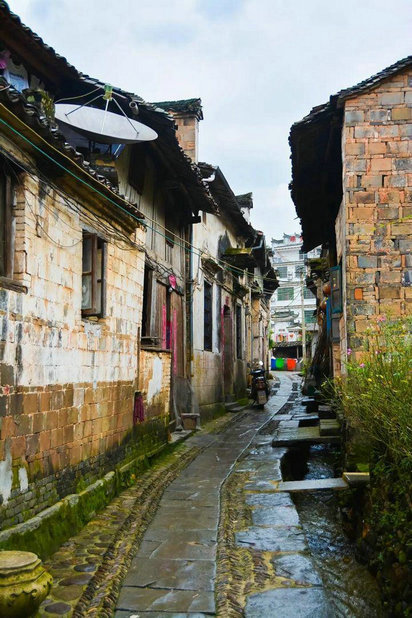
Dongbu Ancient Street is one of the four oldest streets in Fuliang County, consisted of the street, the ancient bridge and the ancient wharf. It was developed from a place busy for transporting kaolin clay in the Ming and Qing Dynasties. Shops lining up the street and dents in the flagstones made by wheel barrows are the best imprints of the busy scene on the wharf at old times.
IV. Nice Ecological Environment and Abundant Resources
Villages in Yaoli were mostly located near water and have stayed there among green mountains for ever. Yaoli also boasts abundant mineral resources but has never been explored, which in some sense keeps the Yaohe River clean and clear from pollution. “There will not be any fish when the water is too clear”, as the saying goes. Yet, this river, clear as it is, is very popular for its fish-watching activities.
Yaoli, at an elevation of 600-900 meters in the mountainous area, has a forest coverage rate up to 94%. The fresh air, the abundant rainfall, and the mild climate provide favorable conditions for agricultural growth. Tea from here, for example, is quite particular. Yaoli enjoys a long history of tea making and is the important tea producer of Fuliang County, sending in history its tea as tribute to the imperial court. The distinct but subtle aroma and the light green color make it one of the three most famous strong-taste tea flavors in the world. Since 1990, Yaoli has been implementing the brand-building strategy and successfully developed its first brand of green tea named “Yayu” in 1991. So far, 2 famous brands with 10 series have been developed. Tea from here has won several national-level prizes. It was accredited “famous tea” in Hangzhou Tea Expo in 1991, won a golden medal in Beijing International Beverage Expo in 1994 and another two golden medals in China International Expo in 1997 and 2002, and was evaluated as 2A-level organic food by the Ministry of Agriculture in 1998 and 2002 respectively. Processed from Yaoli tea as the raw material, “De Yu Huo Cha” is not only the tea exclusively selected for use in the Great Hall of the People, but also sells well in Europe, America, and other countries.
The locals here have developed very rich dietary culture. The ingredients are mostly natural and multifarious. For the breakfast, there are as many as 36 kinds of food, such as pearl rice pie, fried rice ball, and salty rice cake, etc. For the main courses, there are 74 kinds of special dishes, including poached partridge, braised mushroom, and bacon soup with mud fish, etc., and over 28 kinds of wild vegetable with special flavor. After the meals, there are various desserts like pumpkin pies, dried sweet potato cubes, bean dregs, treated eggplant chips, pie with fermented soya bean, pueraria lobata, and so on. Walking on the street of Yaoli, you will also see a wide variety of local specialties.
V. Picturesque Scenery
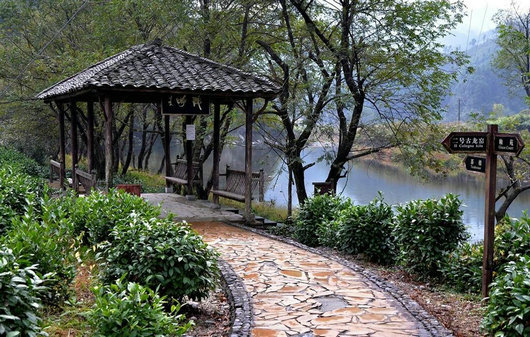
The most attractive sights of Yaoli should be Wanghu Ecological Resort and Meiling Leisure Resort, where jungles and mountains have nurtured more than 648 plants of 95 families and over a hundred wild animal species, and where the waterfalls, the caves, the camphor trees and the primeval forests together have created an magic and idyllic landscape, displaying to tourists and visitors different sights of the four seasons of a year in one time.
Nanshan Waterfall Group in Wanghu Ecological Resort consists of four falls, namely, Nanshan Fall, Shihua Fall, Feilong Fall and Piaojin Fall, with the total drop of all the falls amounting to 220 meters high, the total length of the falls reaching 400 meters, and the main fall having a range of 70 meters. Connected from the first to the last and from rushing torrents to slow drops according to the change of the terrains, each of the falls displays its own distinct feature.
Another spot in Wanghu Ecological Resort is Tianhe Valley and the primeval forests, where the moist air and the luxuriant vegetation from the broad-leaved forest to coniferous forest and from colorful vine trees to flowers and shrubs have made the whole valley a natural botanical garden.
Integrating mountains, woodland, waterfalls, valleys and other natural scenery with the ancient town, the kilns, and other cultural sites, Yaoli Scenic Area has become a famous tourist attraction featured with secluded simplicity, untouched greenery, and comfortable mild climate. If there are“fairylands”in the world, Yaoli is certainly one of them.
VI. Transportation and Communication
About 51 kilometers from Jingdezhen downtown area, Yaoli is just one-hour’s drive away with quality highway. Yuyu highway runs through the whole town and connects it with Mount Huang of Anhui Province. There are flights or high-speed trains from Jingdezhen to Nanchang, Beijing, Shanghai, Nanjing, Wuhan, Guangzhou, Shenzhen, Haikou and other major cities in the country. And communication networks have covered the whole area.
VII. Main Scenic Spots
There are five main scenic spots in Yaoli:
1.Ancient Town of Porcelain and Tea
2.Cheng’s Ancestral Hall
3.Shigang Local Dwellings
4.Shopping Street of Ming-Qing Style
5.Yaoli Museum
6.Former Residence of Marshal Chen Yi
7.Fish Watching on the Yaohe River
Wanghu Ecological Resort
1. Nanshan Fall
2.The Primeval Forest
3.Tianhe Valley
4.Ancient Huizhou Road
The Site of Kaolin Mine
1.Dongbu Scenic Spot
(1)Dongbu Ancient Street
(2)Ancient Wharf
(3)Stone Tablet Signed by Emperor Qianlong
2.The Site of Kaolin Mine
(1)Ancient Kaolin Mine
(2)Golden Rooster Stone
(3)Juxiu Bridge
(4)1000-year Old Camphor Tree
(5)Longkou Fall
(6)Yuling Peak
Raonan Ceramic Theme Park
1. Ancient Water-powered Trip-hammer Workshop
2. Ancient Glaze Stone Workshop
3. Ancient Ceramic Workshop
4. Site of Ancient Loong Kiln
5. Miniature of Water-powered Trip-hammers
Meiling Leisure Resort
1. Zhang’s Ancestral Hall
2. 1000-year Old Camphor Tree Cluster
3. Butterfly Valley
4. Ancient Huizhou Road
5. Meiling Resort

